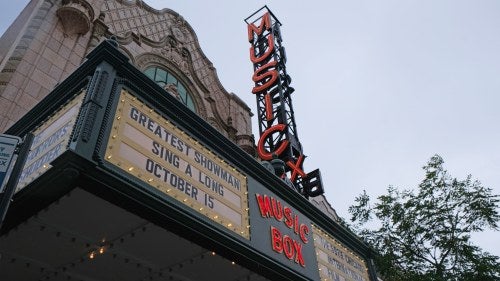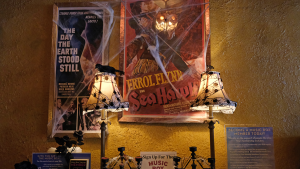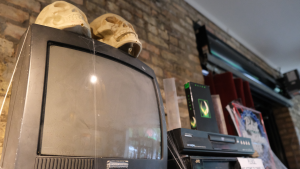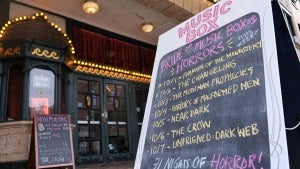'It made me scared of camels': The Music Box Theatre brings international horror to Chicago

The Music Box Theatre brings international horror films to Chicago because they can make you terrified of things you didn't know you could be afraid of. Curators think audiences' shrieks, shouts, and screams bring people and cultures together.
Adorned with a blazing neon sign that towers over the Southport neighborhood, the independent Music Box Theatre has become a Chicago icon by showing cult classics, screening indie discoveries, and hosting out-of-the-box film festivals.
In October, that includes nightly screenings of horror movies and the annual 24-hour horror film festival, which has run since 2004 and draws tourists from neighboring Midwest states and people from Los Angeles and Seattle. The Music Box shows American classics like "Candyman" and "Aliens." But alongside franchise megahits, curators screen little-known international horror films that, in some cases, may have never been seen outside the country where they were produced.
That may seem like a risk, especially as independent theaters struggle to entice audiences back to the movies after the pandemic. Still, Music Box sold 7,800 tickets last October, and it told ChicagoGlobal that it anticipates selling over 8,000 this year.
Music Box’s general manager Ryan Oestreich thinks the bet is paying off because Music Box fans trust his team to show them rare films they’d have a hard time finding anywhere else.
“Horror is like the best genre in the world for showing every type of cinema, every way to tell a story,” he told ChicagoGlobal.
Audiences seem to agree: The 24-hour festival once again sold out just a few days after tickets went live, and October’s spooky season screenings have been so successful that Oestreich and festival programmer Will Morris have started organizing year-round monthly horror screenings.
According to Oestreich and Morris, the theater’s audience is diverse, but it’s largely Gen Z that’s showing up to see international horror films that, in some cases, were made decades before they were born.
During the pandemic, Morris said, “a lot of kids – a lot of people at large – but a lot of kids especially” were streaming movies at home and felt like “all these streaming services are the same.”
“I just get the sense,” Oestreich added, “that people are just hungrier for more ambitious filmmaking – and like unknown filmmaking.”

Vintage horror posters decorate the lobby.

Spooky decorations adorn a television.

Cobwebs cover an aisle sign in the 700-seat theater.

A sign promoting the month-long horror festival.
“The thing that is so important to international horror is [it] can make you scared of something that you did not know you could be scared of,” he said.
“There’s this incredible Iranian horror that made me terrified of sheets,” he confessed. “And then recently, I just watched this film that – I don’t know if you’d consider it horror – but it made me scared of camels.”
Italian horror icons
Some of the first movies ever made were horror movies. For over a century, the genre has remained particularly attractive to filmmakers all over the world because the movies don't require huge budgets: “[There’s] backyard horror movies all the way up to, you know, like "The Exorcist" – huge budget things,” said Morris.
“Nobody was better in the heyday of the world of film than Italy, I don’t think, at speed and cheapness – but still pumping out incredible movies,” he said.
In the mid-twentieth century, Italian directors working on low budgets pioneered Gothic horror, which emphasized atmosphere over realism. In the ‘70s and ‘80s, Italian directors like Dario Argento, Joe D’Amato, and Mario Bava popularized “giallo” horror. Giallo, which means “yellow,” took inspiration from lurid pulp-fiction novels that often came in yellow paperback. Giallo films remain some of the best-known Italian horror films that fans still love.
“I think that’s why people keep getting drawn to it,” Morris added. “There’s definitely no modern day horror without Italy…” and “there’s an “endless well, still to this day” out there to be discovered.
Filipino finds
Filipino horror hasn’t yet found firm footing in the U.S., according to Morris. But last year the Music Box showed 1980’s "The Killing of Satan," which the theater promoted as “a psychedelic blast of gory absurdity, an epic ‘adults only’ comic book filled with dead-serious emotions and dead-serious hilarity.”
Morris describes Filipino horror as “one of the most singular” international horror genres. He sees influences of the ‘80s and ‘90s “shot-on-video” wave in the U.S. — filmmakers use low-budget, handheld camcorders, and scripts don’t usually put too much focus on realism.
“The films all feel like they are made in a universe where there are no rules, and there’s nothing you have to do,” Morris said. “Whether that’s as far as telling a story that people can understand and keep up with, or not crossing certain taboo lines.”
“It’s so exhilarating because there’s nothing else like it.”
J-Horror jams
This year is the 25th anniversary of "Ringu," the Japanese horror film about a deadly videotape that inspired 2002’s "The Ring."
Oestreich points to J-horror as an example of how Hollywood can be shaped by international filmmakers — and not the other way around.
“Not only did they have to remake those films because, you know, a lot of American audiences were unwilling to read subtitles,” Oestreich said, “but after they remade them, how many American horror movies had somebody, like, crawling around, or with long hair?” Recent horror hits like 2023’s "Hereditary" and 2021’s "Malignant" still deploy creepy crawlers and long-haired monsters, almost two decades after popular J-horror remakes like "The Ring" and "The Grudge" hit U.S. theaters.
Oestreich said that he and Morris include international horror in the festival because “we want to remind people that these ideas might have came from somewhere else, and that they might have been done better – and that’s OK!”
After the credits
To close out October, the Music Box is showing a double feature: "Anaconda" and Italy’s "Killer Crocodile," a 1989 Jaws ripoff that “wades waist-deep into the charmingly crude waters of Italian exploitation films.”
On the other side of the spectrum is "Diabolique," a 1955 French horror-thriller that inspired some of Hitchcock’s best-known works, including "Psycho."
Horror is a uniquely powerful genre for building community and connections, Oestreich said, because “there’s a camaraderie that gets built immediately after you experience something together.”
“You weren’t alone in being so disheveled or upset with it. You and everybody else had that same experience.”
That levels the playing field and opens up opportunities to build cross-cultural connections.
“Let’s talk about that experience we all just had,” he said.” “Everybody’s an equal.
This story first appeared in the ChicagoGlobal newsletter, a joint project of Crain's Chicago Business and the Chicago Council on Global Affairs.

